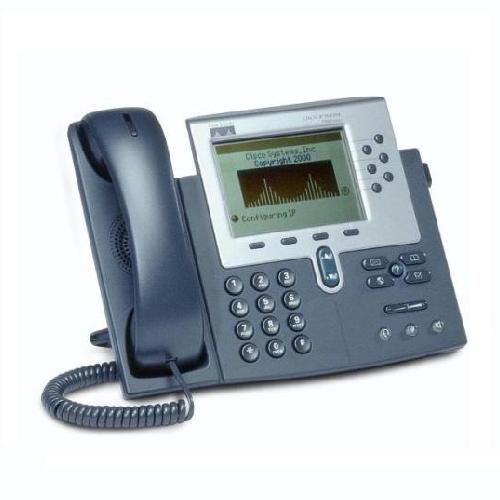CISCO IP PHONE-7960G
The Cisco Unified IP Phone 7960G is "multi-protocol enabled" supporting Session Initiated Protocol (SIP), Media Gateway Control Protocol (MGCP), as well as Cisco's CallManager Skinny Client Control Protocol (SCCP).
The Cisco Unified IP Phone 7960G, a key offering in the IP Phone portfolio, is a fully featured IP phone, perfect for managers and executives, providing six programmable line and feature buttons, and a high quality speakerphone. The Cisco Unified IP Phone 7960G offers four dynamic soft keys that guide a user through call features and functions. Built-in headset port and integrated Ethernet Switch are standard with the Cisco Unified IP Phone 7960G. Also includes audio controls for full duplex speakerphone, handset and headset. The Cisco Unified IP Phone 7960G also features a large, pixel-based LCD display.
Features
The Cisco 7960G is dynamic and designed to grow with system capabilities. Features will keep pace with new changes via software updates to the phone's flash memory. The phone provides many accessibility methods according to user preference. Various methods or paths include buttons, softkeys, a navigation key, and direct access with the use of corresponding "ghost" digits. Each of the features below will have expanded capabilities in the future:
- Messages -- Direct access to voice mail. In the near future voice mail speech to text readout on the display.
- Directories -- The Cisco Unified IP Phone 7960G identifies incoming messages and categorizes them for users on the screen. This allows users to quickly and effectively return calls using direct dial-back capability. The corporate directory integrates with the Lightweight Directory Access Protocol (LDAP3) standard directory.
- Settings -- The Settings feature allows the user to adjust display contrast and select from a large number of ringer sounds, volume settings for all audio such as ringer, handset, headset, and speaker. Network Configuration preferences can also be set up. (Network configuration is usually set up by the System Administrator.)
Configuration can either be automatic or manually set up for Dynamic Host Control Protocol (DHCP), Trivial File Transfer Protocol (TFTP), CallManager, and backup CallManagers.
The internal Cisco two-port Ethernet switch allows for a direct connection to a 10/100BASE-T Ethernet network via an RJ-45 interface with single LAN connectivity for both the phone and a co-located PC. The system administrator can designate separate virtual LANs (VLANs) (802.1Q) for the PC and Cisco IP Phones providing improved security and reliability of voice and data traffic.
A dedicated headset port eliminates the need for a separate amplifier when using a headset. This allows the handset to remain in its cradle, making headset use simpler. The Cisco IP phone's convenient volume control button provides for easy decibel-level adjustments for the speakerphone, handset, headset, and ringer. The handset in HEaring Aid Compatible (HAC) and meets FCC loudness requirements for Americans with Disabilities Act (ADA). Section 508 loudness requirements can be achieved using industry standard inline handset amplifiers such as Walker Equipment W-10 or CE-100 amplifiers.
The dial pad is also ADA compliant.
The footstand of the Cisco 7960G is adjustable from flat to 60 degrees to provide optimum display viewing and comfortable use of all buttons and keys. The footstand is keyed to match standard wall jack configurations for wall mounting. Two optional wall mount brackets are also offered as noted below.
The Cisco Unified IP Phone 7960G can also receive power down the LAN from any of the Cisco inline power-capable blades and boxes.
For added security, the audible dual-tone multifrequency (DTMF) tones are masked when the speakerphone mode is used.
Other Cisco Unified IP Phone 7960G features include:
- 24+ user-adjustable ring tones
- A hearing-aid-compatible handset (meets American Disabilities Act [ADA] requirements) and HAC compliance for magnetic coupling to approved HAC hearing aids
- G.711 and G.729a audio compression
- An IP address assignment—DHCP client or statically configured
- Comfort noise generation and voice activity detection (VAD) programming on a system basis




